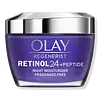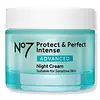What's inside
What's inside
 Key Ingredients
Key Ingredients

 Benefits
Benefits

 Concerns
Concerns

 Ingredients Side-by-side
Ingredients Side-by-side

Water
Skin ConditioningDimethicone
EmollientGlycerin
HumectantTapioca Starch
Dimethicone Crosspolymer
Emulsion StabilisingRetinol
Skin ConditioningRetinyl Propionate
Skin ConditioningNiacinamide
SmoothingPalmitoyl Pentapeptide-4
Skin ConditioningPolyacrylamide
C13-14 Isoparaffin
EmollientDMDM Hydantoin
PreservativePolysorbate 20
EmulsifyingLaureth-4
EmulsifyingAcrylates/C10-30 Alkyl Acrylate Crosspolymer
Emulsion StabilisingLaureth-7
EmulsifyingDimethiconol
EmollientPolymethylsilsesquioxane
Aminomethyl Propanol
BufferingTitanium Dioxide
Cosmetic ColorantDisodium EDTA
Iodopropynyl Butylcarbamate
PreservativeCaprylic/Capric Triglyceride
MaskingAminopeptidase
Skin ConditioningWater, Dimethicone, Glycerin, Tapioca Starch, Dimethicone Crosspolymer, Retinol, Retinyl Propionate, Niacinamide, Palmitoyl Pentapeptide-4, Polyacrylamide, C13-14 Isoparaffin, DMDM Hydantoin, Polysorbate 20, Laureth-4, Acrylates/C10-30 Alkyl Acrylate Crosspolymer, Laureth-7, Dimethiconol, Polymethylsilsesquioxane, Aminomethyl Propanol, Titanium Dioxide, Disodium EDTA, Iodopropynyl Butylcarbamate, Caprylic/Capric Triglyceride, Aminopeptidase
Water
Skin ConditioningGlycerin
HumectantButyrospermum Parkii Butter
Skin ConditioningSorbitan Stearate
EmulsifyingDimethicone
EmollientCetearyl Alcohol
EmollientCaprylic/Capric Triglyceride
MaskingEthylhexyl Stearate
EmollientPolyacrylamide
Butylene Glycol
HumectantC13-14 Isoparaffin
EmollientAlcohol Denat.
AntimicrobialPhenoxyethanol
PreservativeDimethiconol
EmollientParfum
MaskingTribehenin
EmollientDipropylene Glycol
HumectantSucrose Cocoate
EmulsifyingMethylparaben
PreservativeCarbomer
Emulsion StabilisingLaureth-7
EmulsifyingPropylene Glycol
HumectantTocopheryl Acetate
AntioxidantSodium Hyaluronate
HumectantAscorbyl Glucoside
AntioxidantEthylparaben
PreservativeRetinyl Palmitate
Skin ConditioningXanthan Gum
EmulsifyingHydrolyzed Rice Protein
Skin ConditioningTetrasodium EDTA
Sorbitan Laurate
EmulsifyingPotassium Hydroxide
BufferingPanax Ginseng Root Extract
EmollientDimethylmethoxy Chromanol
AntioxidantMedicago Sativa Extract
TonicPolysorbate 20
EmulsifyingHydroxyethylcellulose
Emulsion StabilisingAcetyl Dipeptide-1 Cetyl Ester
Skin ConditioningMorus Alba Leaf Extract
Skin ConditioningLindera Strychnifolia Root Extract
Skin ConditioningSodium Benzoate
MaskingTocopherol
AntioxidantEthylhexylglycerin
Skin ConditioningPalmitoyl Tripeptide-1
Skin ConditioningPalmitoyl Tetrapeptide-7
Skin ConditioningWater, Glycerin, Butyrospermum Parkii Butter, Sorbitan Stearate, Dimethicone, Cetearyl Alcohol, Caprylic/Capric Triglyceride, Ethylhexyl Stearate, Polyacrylamide, Butylene Glycol, C13-14 Isoparaffin, Alcohol Denat., Phenoxyethanol, Dimethiconol, Parfum, Tribehenin, Dipropylene Glycol, Sucrose Cocoate, Methylparaben, Carbomer, Laureth-7, Propylene Glycol, Tocopheryl Acetate, Sodium Hyaluronate, Ascorbyl Glucoside, Ethylparaben, Retinyl Palmitate, Xanthan Gum, Hydrolyzed Rice Protein, Tetrasodium EDTA, Sorbitan Laurate, Potassium Hydroxide, Panax Ginseng Root Extract, Dimethylmethoxy Chromanol, Medicago Sativa Extract, Polysorbate 20, Hydroxyethylcellulose, Acetyl Dipeptide-1 Cetyl Ester, Morus Alba Leaf Extract, Lindera Strychnifolia Root Extract, Sodium Benzoate, Tocopherol, Ethylhexylglycerin, Palmitoyl Tripeptide-1, Palmitoyl Tetrapeptide-7
 Reviews
Reviews

Ingredients Explained
These ingredients are found in both products.
Ingredients higher up in an ingredient list are typically present in a larger amount.
This ingredient is also known as "C13-14 Isoalkane".
C13-14 Isoparaffin is created from petroleum-based mineral oils. It is an emollient and helps thicken a product.
As an emollient, it helps keep the skin soft and smooth by creating a barrier on top. This barrier traps moisture in, keeping the skin hydrated.
C13-14 Isoparaffin may not be fungal-acne safe.
Learn more about C13-14 IsoparaffinThis ingredient is an emollient, solvent, and texture enhancer. It is considered a skin-softener by helping the skin prevent moisture loss.
It helps thicken a product's formula and makes it easier to spread by dissolving clumping compounds.
Caprylic Triglyceride is made by combining glycerin with coconut oil, forming a clear liquid.
While there is an assumption Caprylic Triglyceride can clog pores due to it being derived from coconut oil, there is no research supporting this.
Learn more about Caprylic/Capric TriglycerideDimethicone is a type of synthetic silicone created from natural materials such as quartz.
What it does:
Dimethicone comes in different viscosities:
Depending on the viscosity, dimethicone has different properties.
Ingredients lists don't always show which type is used, so we recommend reaching out to the brand if you have questions about the viscosity.
This ingredient is unlikely to cause irritation because it does not get absorbed into skin. However, people with silicone allergies should be careful about using this ingredient.
Note: Dimethicone may contribute to pilling. This is because it is not oil or water soluble, so pilling may occur when layered with products. When mixed with heavy oils in a formula, the outcome is also quite greasy.
Learn more about DimethiconeDimethiconol is a silicone that resembles the popular dimethicone. Like other silicones, it is an emollient. Emollients create a thin film on skin to prevent moisture from escaping.
This ingredient helps to create a silky texture and improve spreadability. Due to its high molecular weight and thickness, it is often combined with cyclopentasiloxane.
Glycerin is already naturally found in your skin. It helps moisturize and protect your skin.
A study from 2016 found glycerin to be more effective as a humectant than AHAs and hyaluronic acid.
As a humectant, it helps the skin stay hydrated by pulling moisture to your skin. The low molecular weight of glycerin allows it to pull moisture into the deeper layers of your skin.
Hydrated skin improves your skin barrier; Your skin barrier helps protect against irritants and bacteria.
Glycerin has also been found to have antimicrobial and antiviral properties. Due to these properties, glycerin is often used in wound and burn treatments.
In cosmetics, glycerin is usually derived from plants such as soybean or palm. However, it can also be sourced from animals, such as tallow or animal fat.
This ingredient is organic, colorless, odorless, and non-toxic.
Glycerin is the name for this ingredient in American English. British English uses Glycerol/Glycerine.
Learn more about GlycerinLaureth-7 is created by the ethoxylation of lauryl alcohol using ethylene oxide. Lauryl alcohol is a fatty alcohol with hydrating properties.
This ingredient is an emulsifier and cleansing ingredient. As an emulsifier, it is used to prevent ingredients from separating. It also helps cleanse the skin by gathering dirt, oil, and pollutants to be rinsed away.
Polyacrylamide is a synthetic polymer. It is used to stabilize products and bind ingredients. When hydrated, Polyacrylamide forms a soft gel.
Polyacrylamide is low-toxicity. If source properly, it is deemed safe to use in cosmetics.
It should be noted the precursor to Polyacrylamide is acrylamide. Acrylamide is a carcinogen. Most reputable sources of Polyacrylamide will screen for residual acrylamide to make sure the count is in a safe range. Acrylamide is not able to be absorbed through the skin.
We recommend speaking with a professional if you have concerns.
Learn more about PolyacrylamidePolysorbate 20 is made by combining ethoxylation of sorbitan, ethylene oxide, and lauric acid. It is a mild cleansing agent, surfactant, and emulsifier.
As a surfactant, it helps collect dirt and oils for washing. Emulsifiers prevent oils and water from separating.
Polysorbate 20 also adds scent to a product. Since it is made using sorbitol, it has a sweet scent. Sorbitol can also be found in fruits such as apples and peaches.
The lauric acid used to create Polysorbate 20 is often derived from coconuts.
Polysorbate 20 may not be fungal acne safe.
Learn more about Polysorbate 20Water. It's the most common cosmetic ingredient of all. You'll usually see it at the top of ingredient lists, meaning that it makes up the largest part of the product.
So why is it so popular? Water most often acts as a solvent - this means that it helps dissolve other ingredients into the formulation.
You'll also recognize water as that liquid we all need to stay alive. If you see this, drink a glass of water. Stay hydrated!
Learn more about Water